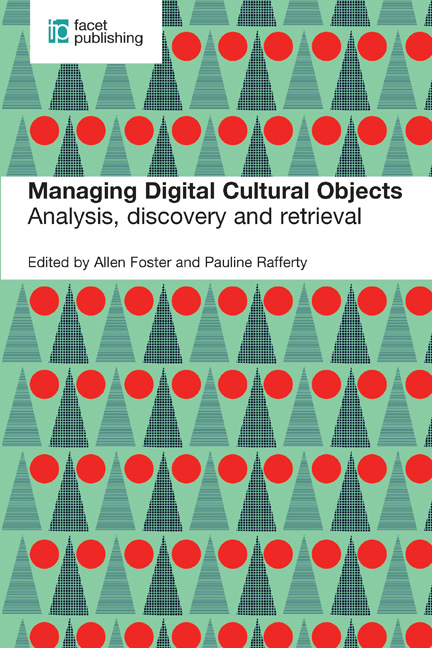Book contents
- Frontmatter
- Contents
- List of figures and tables
- Contributors
- Introduction
- PART 1 ANALYSIS AND RETRIEVAL OF DIGITAL CULTURAL OBJECTS
- PART 2 DIGITIZATION PROJECTS IN LIBRARIES, ARCHIVES AND MUSEUMS: CASE STUDIES
- 4 Visual digital humanities: using image data to derive approximate metadata
- 5 Managing and preserving digital collections at the British Library
- 6 Digital preservation of audio content
- PART 3 SOCIAL NETWORKING AND DIGITAL CULTURAL OBJECTS
- Index
5 - Managing and preserving digital collections at the British Library
from PART 2 - DIGITIZATION PROJECTS IN LIBRARIES, ARCHIVES AND MUSEUMS: CASE STUDIES
Published online by Cambridge University Press: 09 June 2018
- Frontmatter
- Contents
- List of figures and tables
- Contributors
- Introduction
- PART 1 ANALYSIS AND RETRIEVAL OF DIGITAL CULTURAL OBJECTS
- PART 2 DIGITIZATION PROJECTS IN LIBRARIES, ARCHIVES AND MUSEUMS: CASE STUDIES
- 4 Visual digital humanities: using image data to derive approximate metadata
- 5 Managing and preserving digital collections at the British Library
- 6 Digital preservation of audio content
- PART 3 SOCIAL NETWORKING AND DIGITAL CULTURAL OBJECTS
- Index
Summary
Introduction
The British Library is one of the greatest research libraries in the world, serving business and industry, researchers and academics, in the UK and worldwide. Our collection items range from Chinese oracle bones over 3000 years old, the first edition of The Times in 1788 and the Magna Carta, to Beatles’ manuscripts, modern patents, maps and journal titles. Alongside these physical artefacts we hold an increasing amount of digital material. Digitization of our collection began as early as the 1990s, with the creation of digital surrogates of Library treasures such as the Beowulf manuscript, the Lindisfarne Gospels, Shakespeare Folios, and musical manuscripts from Handel, Bach and Mozart. More recently we have entered the world of mass digitization projects: for example, the Google Books project and the Brightsolid newspaper digitization programme. At the same time we have acquired an increasing amount of born-digital content and we now have a sizable collection of such content, ranging from digital audio/video recordings and digital maps to personal digital archives, e-journals and archived websites. In all, we estimate we already have over 300 terabytes of collection content – or over 12 million items – stored in our long-term digital library system, with more awaiting ingest. The rate of acquisition has significantly increased since the onset of nonprint legal deposit legislation in 2013, with around 4.8 million websites, 120,000 e-journal articles and 12,000 e-books collected in the first year alone. Current estimates predict that the total size of our collection will increase massively in future years to around 5 petabytes by 2020.
With acquisition comes responsibility. We must be able to adequately preserve our collection content for access by future users, regardless of acquisition form or format, and despite inevitable changes in not only storage media and hardware but also file formats, operating systems and software applications. We must ensure that bits do not rot and that the intellectual content of our digital collections remains available to users for the next 20, 50, 100, 200 years and beyond. For digital collections this requires investment in collection management and preservation practices across the entire lifecycle, from the point of acquisition onwards.
Information
- Type
- Chapter
- Information
- Managing Digital Cultural ObjectsAnalysis, discovery and retrieval, pp. 111 - 128Publisher: FacetPrint publication year: 2016
Accessibility standard: Unknown
Why this information is here
This section outlines the accessibility features of this content - including support for screen readers, full keyboard navigation and high-contrast display options. This may not be relevant for you.Accessibility Information
- 1
- Cited by
